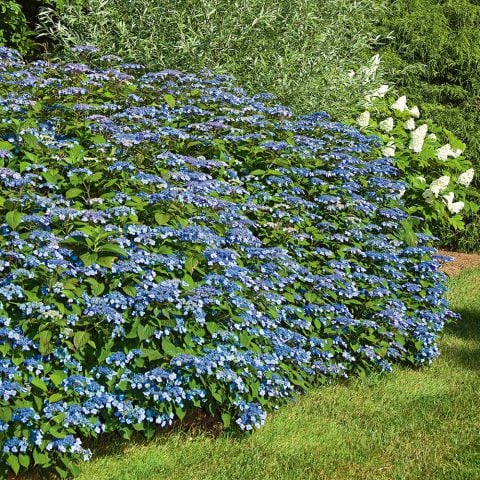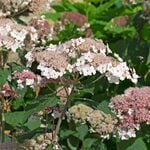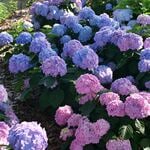How to Grow Hydrangeas
Latin Name Pronunciation: hye-dran'jee-uh
Hydrangeas comprise a variable group of bushes and trees beloved for its delicate clusters of papery flowers, borne between July and September depending on the variety. Elegant and eye-catching, Hydrangeas bring a stately, old-fashioned feel to the landscape.
It’s not hard to grow beautiful and healthy Hydrangeas as long as you plant them where they will be happiest: in rich, evenly moist soil, in partial shade from afternoon sun. One of the keys to growing stunning Hydrangeas is knowing when and how to prune particular varieties for the best flower display. Most grow quite quickly under good culture and are long-lived.
Hydrangea Care
Light/Watering: Most varieties tolerate full sun in the North, but benefit from afternoon shade. In the South, plants require afternoon shade. Moist soils that do not dry out are best; do not plant in hot, dry, exposed sites. Mulch to conserve moisture and buffer soil temperatures. Water new plantings regularly and check all Hydrangeas during prolonged dry spells, apply water when needed.
Pests/Diseases: None serious. Hydrangeas are deer resistant (see the caveat below). Occasionally powdery mildew will infect the foliage, especially in humid areas with poor air circulation. Treat with an appropriate fungicide if the problem is serious, and be sure to rake up and destroy all fallen foliage in the autumn.
Companion Plants: Old-fashioned tawny Daylilies are a classic combination with the PeeGee or Tree Hydrangea (H. paniculata 'Grandiflora'). Astilbes and Oriental Lilies in shades of rose, pink, and white are lovely with the shrubby Hydrangeas.
Fertilizer/Soil : Fertilize once in spring with a fertilizer designed to encourage blooms—such as 15-30-15. Soils should be moist but well drained, with more organic matter if possible.
Soil pH & Changing Hydrangea Color: In some varieties of H. macrophylla and H. serrata flower color is determined by the pH of the soil. We have noted on each of our product pages whether the color can be changed with soil amendments. Adjusting pH can be done with commercial soil additives specifically designed for Hydrangeas. In general, acid soils give blue flowers and alkaline soils yield pink flowers. Flower colors can range from purples to blue to pink depending on your soil.
How to test your soil?
We recommend that you visit your local Cooperative Extension Service to find out about soil testing in your area. Follow this link for a directory of institutions involved in the Cooperative Extension program.
We also offer a Soil pH Meter, which allows you to test your soil and provides quick, accurate results.
Pruning Hydrangeas
The type of Hydrangea you have will determine how you prune it, so it is important to know the specific variety you are growing. Remember that pruning should be done judiciously and only to remove dead wood or when the plant is too large for the space. For additional information, please watch our video below.
Pruning is based on “old wood” versus “new wood” for Hydrangeas.
Old wood is the growing point (bud) or tip of a branch that survived through the winter months. On some varieties, the flower buds are present here and therefore should not be removed with spring or early summer pruning.
New wood refers to branches with growing points (buds) that have emerged after winter. They may come from the base of the plant. Take care not to prune the new wood growth, as that would also remove the buds and flowers for these Hydrangeas.
How to Prune Specific Types of Hydrangeas
H. petiolaris: Prune to shape and control size right after flowering. Blooms on old wood.
H. arborescens: Prune after flowering in late fall or in early Spring before new growth appears. Blooms on new wood. Explore our selection of H. arborescens.
H. macrophylla: Flowers on old wood or in the case of newer hybrids, blooms can appear on old and new wood. Prune only to control size and remove dead wood that persists into the growing season.
Blooms on old wood only:
Selections that bloom on both old and new wood:
Hydrangea macrophylla Everlasting® Revolution
Hydrangea macrophylla Everlasting® Amethyst
Hydrangea macrophylla 'Wedding Gown'
Hydrangea macrophylla Let's Dance® Blue Jangles®
Hydrangea macrophylla Let's Dance® Rave®
Hydrangea macrophylla 'Let's Dance® Rhythmic Blue™
Hydrangea macrophylla Endless Summer® Summer Crush™
Hydrangea macrophylla Cherry Explosion
Hydrangea macrophylla Endless Summer®
Hydrangea macrophylla Let's Dance Big Band®
H. paniculata: Prune to encourage branching and to shape in early Spring before new growth appears. Blooms on new wood. Explore our selection of H. paniculata.
Tree form paniculata: Prune to shape in early Spring before new growth appears. Can prune in late fall to keep head size compact and reduce ice and snow damage. Explore our selection of Tree form Hydrangeas.
H. quercifolia: Young plants can be pruned to promote branching but flowers will not appear until the following year. Prune only when needed to control size. Blooms on old wood. Explore our selection of H. quercifolia.
H. serrata: Only prune to control size right after flowering. Our selection Hydrangea serrata 'Blue Billow' blooms on old wood.
H. serrata hybrids: Only prune to control size right after flowering. Our selection Hydrangea serrata Tiny Tuff Stuff™ blooms on old and new wood.
Video: How to Prune Hydrangeas
Calendar of Care for Hydrangeas
Spring: Prune Hydrangea varieties as indicated above, according to their species. Prune out any dead wood from all varieties. Check soil pH and adjust up or down if needed for desired flower color of H. macrophylla and H. serrata. Feed plants with a fertilizer high in phosphorus (such as 15-30-15) to encourage blooms. Complete any transplanting in early spring before leaves unfurl (prune top growth after transplanting to reduce water loss). Mulch plants after soil has warmed to conserve moisture and buffer soil temperatures. Watch for powdery mildew and treat as needed.
Summer: As soon as blooms fade, remove spent flowers from H. macrophylla, H. quercifolia, and H. serrata varieties. Cut flowering stems from H. arborescens 'Annabelle' and hang to dry if desired. Rebloom may then occur in August or September.
Fall: Remove and destroy any fallen foliage that was infected by powdery mildew. In Zone 5, cover the stems of H. macrophylla varieties with a 12” layer of organic material such as straw or mulched leaves to help flower buds overwinter. You may also wrap your Hydrangea with burlap to protect it from winds and cold temperatures.
Frequently Asked Questions
How to plant Hydrangeas?
Begin by checking the moisture of the potting mix in the container. Water thoroughly if it's dry. Then dig a hole several times the diameter of the root ball but no deeper than the height of the root ball. Remove the plant from the pot and gently break up the sides of the root ball with your thumbs (you may find it easier to make several vertical cuts with a knife) and set it in the center of the hole. Push soil back into the hole and just over the top of the root ball, firm the soil with your hands or feet, and soak with a hose set to a slow trickle. A ring of soil 1-2' in diameter mounded around the main stem will catch and hold water and channel it down to the roots.
Is Hydrangea a perennial?
Yes, Hydrangeas are perennials: they go dormant in winter and come back in the spring on their own, assuming you've planted varieties suited for your Zone. Gardeners in northern Zones must take care to choose winter-hardy varieties.
Can I plant Hydrangeas in pots?
The following varieties can be grown in containers due to their smaller scale, for a short duration while in bloom during the gardening season: H. m. Endless Summer®, H.m. Endless Summer® Summer Crush™, H. s. Tuff Stuff™, H.p. Bobo™, H.m. Cherry Explosion, and H.p. Little Quick Fire®. However, winter care is a factor, and selecting the correct plant and pot is important. Choose a container that is lightweight and not clay or glazed-based. If you plan to keep your plant in a container year after year, you will have to move it to a sheltered location during the winter, such as an unheated garage.
When to plant Hydrangeas
Hydrangeas can be planted in the spring or in the fall when the plants have time to develop strong root systems before being exposed to summer and winter temperature extremes.
Do deer eat Hydrangeas?
While deer don't generally seek out Hydrangeas, if they are hungry enough, they will eat any plant available. If you live in an area where deer are a problem, consider these tips for creating a deer resistant garden.
Where to buy Hydrangeas
White Flower Farm offers a huge selection of Hydrangea varieties for online ordering.
Growing Hydrangeas - Additional Video Guides
What are the Various Types of Hydrangeas?
Why didn't my Hydrangea Bloom?
Hydrangea arborescens 'Annabelle'
Hydrangea macrophylla Endless Summer™






